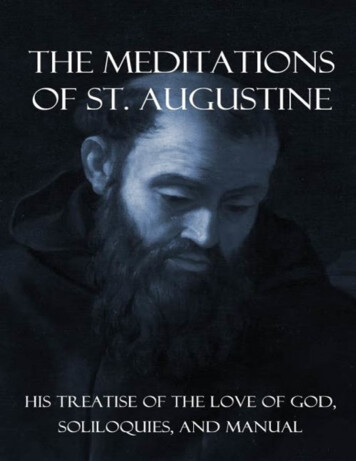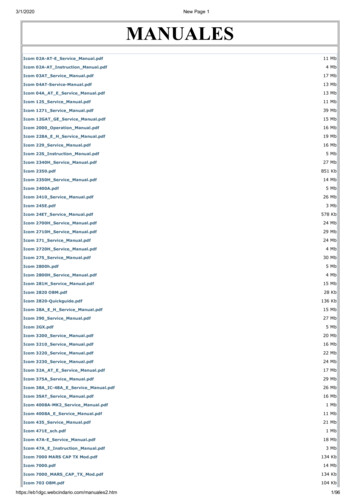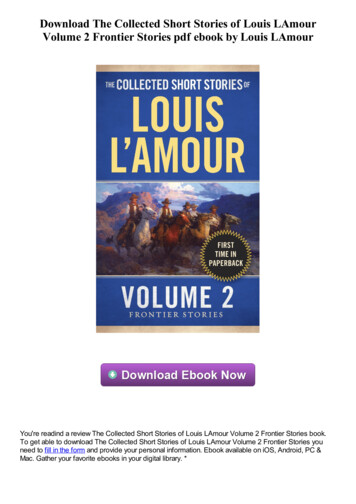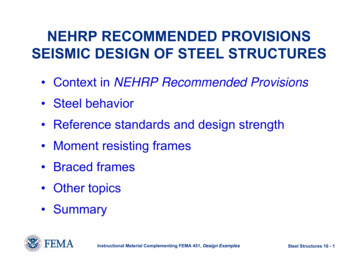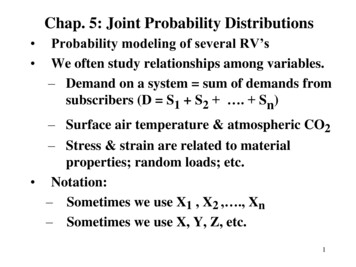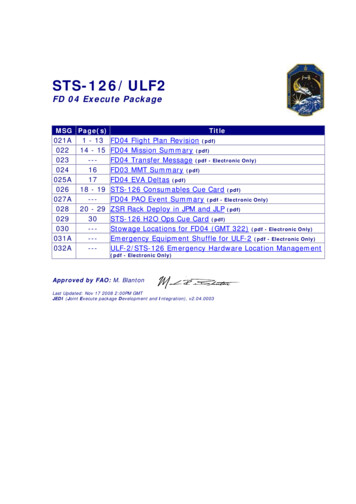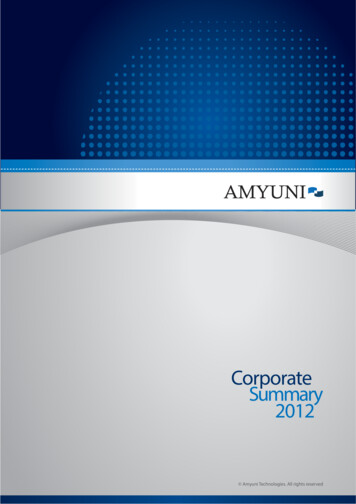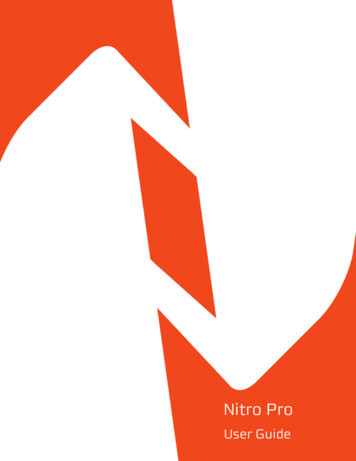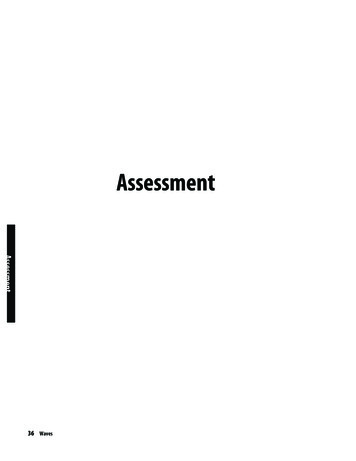
Transcription
AssessmentAssessment36 Waves
NameDateClassWavesChapterReviewPart A. Vocabulary ReviewDirections: Choose the correct term from the list below and write it in the space beside each definition.amplitudecrestlaw of reflectionrefractiontransverse onresonancetroughwavelengthcompressional waveinterferencereflectionstanding wavewaves1. when a wave strikes an object and bounces off2. repeating disturbances that transfer energy through matter or space3. highest point of a transverse wave4. region where the medium is crowded and dense in a compressionalwave5. wave that makes matter in the medium move back and forth at rightangles to the direction the wave travels6. ability of two or more waves to combine and form a new wave8. material through which a wave transfers energyAssessmentCopyright Glencoe/McGraw-Hill, a division of the McGraw-Hill Companies, Inc.7. lowest point of a transverse wave9. the bending of waves around a barrier10. less dense region of a compressional wave11. ability of an object to vibrate by absorbing energy at its naturalfrequency12. wave in which matter in the medium moves back and forth in thesame direction the wave travels13. distance between one point in a wave and the nearest point just like it14. measure of how many wavelengths pass a fixed point each second15. the angle of incidence is equal to the angle of reflection16. measure of the energy in a wave17. a special type of wave pattern that forms when waves of equal wavelength and amplitude traveling in opposite directions continuouslyinterfere with each other18. the bending of a wave caused by a change in its speed as it movesfrom one medium to anotherWaves37
NameDateClassChapter Review (continued)Part B. Concept ReviewDirections: Use the diagram below to answer questions 1–5.caABbd1. What type of wave is wave A?2. Which wave carries more energy?3. What do points a and c represent?4. What do points b and d represent?5. How does the frequency of wave B compare with that of wave A?Directions: Using the equation v λ f, find the missing values.7. A wave with a wavelength of 15 m travels at 330 m/s. Calculate its frequency.AssessmentDirections: Answer the following questions on the lines provided.8. How do scientists know that seismic waves can be either compressional or transverse?9. Why do surfers like water waves with high amplitudes?10. Will loud sounds from traffic near a school break glass objects inside the school? Explain.38 WavesCopyright Glencoe/McGraw-Hill, a division of the McGraw-Hill Companies, Inc.6. What is the velocity of a wave with a frequency of 760 Hz and a wavelength of 0.45 m?
NameDateChapterTestClassWavesI. Testing ConceptsDirections: Fill in the blanks using the terms listed below. Some terms may not be verse waveinterferencewave speedreflectionamplitudeseismic ncompressional wavestanding waveresonance1. In a transverse wave, the is the lowest point.2. Adding energy at the natural frequency of an object is called .3. The number of ocean waves that pass a buoy in one second isthe of the wave.4. The of a transverse wave is its highest point.5. To find the of a wave, measure the distance from one trough tothe next trough.6. When the string of a violin is played with a bow, the violin vibrates7. Water waves bending around a dock is an example of .8. The of a wave is a measure of the energy it carries.9. In a compressional wave in a coiled spring, a is where the coilsare spread out.10. A is a repeating disturbance that transfers energy throughmatter or space.11. Waves bending because of a change in speed is called .12. The medium vibrates perpendicular to the direction the wave travels in a.13. When you squeeze the coils of a spring together, you cause a .14. The is the material through which a mechanical wave travels.15. occurs when two waves combine to form a new wave.16. The type of wave made by squeezing the coils of a spring and letting them go isa .Waves39AssessmentCopyright Glencoe/McGraw-Hill, a division of the McGraw-Hill Companies, Inc.in .
NameDateClassChapter Test (continued)II. Understanding ConceptsSkill: Interpreting a Scientific DiagramDirections: Use the diagram to answer questions 1 and 2.CAB1. In the diagram, identify each part by filling in the blanks below.a.b.c.AssessmentSkill: Measuring DataDirections: Match the units in one column to the quantities they measure in the other column by writing thecorrect letter in the space provided.3. wavelengtha. meter4. frequencyb. meters/second5. wave speedc. hertzDirections: Circle the word in parentheses that makes each statement correct.6. If an obstacle is much larger than the wavelength of a wave, almost no (refraction, reflection,diffraction) occurs.7. When you shake a rope up and down, you create a (transverse, compressional, seismic) wave.8. When part of Earth’s crust breaks, (seismic, tidal, uniform) waves pass through Earth.9. In a given medium, as the frequency of a wave increases, its speed (increases, decreases,remains the same).10. In a standing wave, the point at which the medium doesn’t move is called the (antinode,node, compression).40 WavesCopyright Glencoe/McGraw-Hill, a division of the McGraw-Hill Companies, Inc.2. What is the relationship between A and B in the diagram?
NameDateClassChapter Test (continued)III. Applying ConceptsDirections: Answer the following questions on the lines provided.1. How do particles move differently in transverse waves and in surface water waves?2. A student holds a metal bar and strikes it with a hammer (a) in a direction parallel to itslength, and (b) in a direction at right angles to its length. What kinds of waves are produced ineach case?a.b.3. Why don’t all loud sounds cause glass objects to break?AssessmentCopyright Glencoe/McGraw-Hill, a division of the McGraw-Hill Companies, Inc.4. A light wave passes at an angle through a chunk of glass into the air. What happens to it inrespect to the normal? Why?5. In a standing wave, what kind of interference is producing the crests and the nodes?Directions: For questions 6 through 9 identify the parts of a transverse wave indicated.68796.7.8.9.10. A sound wave with a frequency of 260 Hz has a wavelength of 130 m. What is the speed of thewave?Waves41
NameDateClassChapter Test (continued)IV. Writing SkillsDirections: Answer the following questions using complete sentences.1. The Moon does not produce light by itself. How do we get moon light?2. In a given medium, how are wavelength and frequency of a wave related? Using this relationship,state which would be more diffracted, waves with high frequency or waves with low frequency.3. How do you know that light is a kind of wave that can travel without a medium?4. You are creating a wave on a rope by shaking the rope back and forth. If you shake your handthe same distance but faster, what happens to the amplitude, frequency, wavelength, and speed?Assessment6. When two waves interfere, is there a loss of energy in the system? Explain.7. Explain why you can see your reflection in an unbroken mirror but cannot see your reflectionin a broken mirror.8. How can sound waves with different frequencies be produced by the same guitar string?42 WavesCopyright Glencoe/McGraw-Hill, a division of the McGraw-Hill Companies, Inc.5. When refraction takes place because a wave is passing from one medium to another mediumwith a different density, at what part of the media does the refraction take place?
Transparency ActivitiesTransparencyActivitiesWaves43
Name1DateSection FocusTransparency ActivityClassWave to the CameraTransparency Activities1. Describe the different waves in this picture.2. If you are swimming underwater, can you still hear the noisesaround you? What does this tell you about sound waves?3. What does light travel through as it goes from the Sun to the eyes ofan underwater swimmer?44 WavesCopyright Glencoe/McGraw-Hill, a division of the McGraw-Hill Companies, Inc.How many waves can you pick out in this scene? Is light described asa wave? If you were there when this photograph was taken, you mightalso mention the sound waves.
Name2DateSection FocusTransparency ActivityClassBig Fiddle, Little FiddleTransparency ActivitiesCopyright Glencoe/McGraw-Hill, a division of the McGraw-Hill Companies, Inc.Have you ever heard the instruments below played? If you have,you probably noticed that the bass produces a much lower soundthan the violin. The difference in the sounds is related to differencesin the waves each instrument produces.1. Name some muscial instruments. How are the instruments younamed played?2. A cello is bigger than a violin but smaller than a bass. How do youthink the sound made by a cello compares to the sounds made byviolins and basses?Waves45
Name3DateSection FocusTransparency ActivityClassWave ArtTransparency Activities1. What do the waves look like before they reach the wall? What dothey look like after passing through the opening?2. Where do the waves in the photograph overlap?3. What do you think this picture would look like if both holes wereplugged?46 WavesCopyright Glencoe/McGraw-Hill, a division of the McGraw-Hill Companies, Inc.This artistic picture shows how waves can make fascinating patternsin water. When waves travelling toward the wall reach the openings,they pass through them. After passing through the openings, thewaves create new patterns as they overlap on the other side of the wall.
DateTransparency ActivitiesRest positionTeaching Copyright Glencoe/McGraw-Hill, a division of the McGraw-Hill Companies, Inc.NameClassAmplitude of WavesWaves47
NameTeaching Transparency ActivityDateClass(continued)1. What is the highest point of a wave called?2. What is the lowest point of a wave called?3. How is the amplitude of a wave measured?4. How is wavelength measured?5. What is frequency?Transparency ActivitiesCopyright Glencoe/McGraw-Hill, a division of the McGraw-Hill Companies, Inc.6. What does the amplitude of a wave measure?48 Waves
NameDateAssessmentTransparency ActivityClassWavesDirections: Carefully review the table and answer the following questions.Electromagnetic Waves in Your LifeShortestwavelength (cm)Longestwavelength (cm)Radio waves0.110,000,000Microwaves0.1100Red light0.0000630.000076Green light0.0000490.000056Blue light0.0000450.000049X rays0.0000000010.0000011. Electromagnetic waves of different wavelengths have been givendifferent names. According to the table, which type of electromagnetic wave can have a wavelength greater than 5 m?A Radio wavesC Red lightB MicrowavesD Blue light2. According to the table, which type of electromagnetic wave canhave a wavelength of 0.000046 cm?F Radio wavesH Red lightG MicrowavesJ Blue lightTransparency ActivitiesCopyright Glencoe/McGraw-Hill, a division of the McGraw-Hill Companies, Inc.Type of wave3. If a device were emitting an electromagnetic wave of 0.00000001 cm,what kind of device would it be?A RadioC FlashlightB Microwave ovenD X-ray machineWaves49
Teacher Supportand PlanningTeacher Support and PlanningContent Outline for Teaching . . . . . . . . . . . . . . . . . . . . . . . . . . . . . . T2Spanish Resources . . . . . . . . . . . . . . . . . . . . . . . . . . . . . . . . . . . . . . . T5Teacher Guide and Answers. . . . . . . . . . . . . . . . . . . . . . . . . . . . . . . . T9WavesT1
Section 1WavesThe Nature of WavesA. Wave—a repeating disturbance or movement that transfers energythrough matter or spaceUnderlined words andphrases are to be filledin by students on theNote-taking Worksheet.1. Molecules pass energy on to neighboring molecules.2. Waves carry energy without transporting matter.3. All waves are produced by something that vibrates.4. Medium—a material through which a wave travels.a. May be solid, liquid, or gasb. Not all waves need a medium to travel through. Example: Light wavesB. Mechanical waves—waves that can travel only through matter1. Transverse waves—matter in the medium moves back and forth at right angles to thedirection that the wave travels. Example: Water waves2. Compressional waves—matter in the medium moves in the same direction that the wavetravels. Example: Sound waves3. Combinations—not purely transverse or compressional; examples: water waves, seismicwavesDISCUSSION QUESTION:How are sounds made? When somebody vibrates their vocal chords or slams a door, air particles arepushed together. This starts a sequence of compressions in the air that make a wave. The air particlespass the energy on to neighboring air particles. When the wave reaches your ear, it causes youreardrum to vibrate. Your inner ear sends signals to your brain, which your brain interprets as sounds.Section 2Wave PropertiesA. Ways waves differ1. How much energy they carry2. How fast they travel3. How they looka. Transverse waves have crests—the highest points, and troughs—the lowest points.b. Compressional waves have dense regions called compressions and less dense regionscalled rarefactions.T2 WavesCopyright Glencoe/McGraw-Hill, a division of the McGraw-Hill Companies, Inc.Teacher Support & PlanningContent Outlinefor Teaching
Teacher Support & PlanningContent Outline for Teaching (continued)B. Wavelength—the distance between one point in the wave and the nearest point just like itC. Frequency—how many wavelengths pass a fixed point each second1. Expressed in hertz (Hz)2. As frequency increases, wavelength decreases.3. The frequency of a wave equals the rate of vibration of the source that creates it.D. Wave velocity, or v, describes how fast the wave moves forward.1. velocity wavelength frequency, or v λ f.2. Light waves travel faster than sound waves.3. Sound waves travel faster in liquids and solids than in gas.4. Light waves travel faster in gases and empty space than in liquids and solids.E. Amplitude—a measure of the energy in a wave1. The more energy a wave carries, the greater its amplitude.2. Amplitude of compressional waves is related to how tightly the medium is pushed togetherat the compressionCopyright Glencoe/McGraw-Hill, a division of the McGraw-Hill Companies, Inc.a. The denser the compressions, the larger the amplitude is and the more energy the wave carriesb. The less dense the rarefactions, the larger the amplitude and the more energy the wave carries3. Amplitude of transverse wavesa. The distance from the crest or trough of a wave to the normal position of the mediumb. Example: how high an ocean wave appears above the water levelDISCUSSION QUESTION:In a thunderstorm, why do you see the lightning before you hear the thunder? Light waves travelmuch faster than sound waves.Section 3The Behavior of WavesA. Reflection occurs when a wave strikes an object and bounces off of it.1. All types of waves can be reflected.2. The angle of incidence of a wave is always equal to the angle of reflection.a. Normal—an imaginary line perpendicular to a reflective surfaceb. Angle of incidence—the angle formed by the wave striking the surface and the normalWavesT3
c. Angle of reflection—the angle formed by the reflected wave and the normalB. Refraction—the bending of a wave caused by a change in its speed as it moves from onemedium to another1. The greater the change in speed is, the more the wave bends.2. When a wave passes into a material that slows it down, the wave is bent toward the normal.3. When a wave passes into a material that speeds it up, the wave is bent away from the normal.C. Diffraction—an object causes a wave to change direction and bend around it1. If the obstacle is smaller than the wavelength, the wave diffracts a lot.2. If the obstacle is much larger than the wavelength, the wave does not diffract much.3. The larger the obstacle is compared to the wavelength, the less the waves will diffract.D. Interference—the ability of two or more waves to combine and form a new wave1. Waves pass right through each other and continue in their original direction.2. New wave exists only while the two original waves continue to overlap.3. Constructive interference—waves add together4. Destructive interference—waves subtract from each otherE. Standing waves—a wave pattern that stays in one place1. Form when waves of equal wavelength and amplitude that are traveling in oppositedirections continuously interfere with each other.2. Nodes—the places where two waves always cancel each otherF. Resonance—the ability of an object to vibrate by absorbing energy at its natural frequencyDISCUSSION QUESTION:How do you think wave behaviors apply to music? Constructive interference causes sound waves tobecome louder; destructive interference causes sound waves to become more quiet. Standing waves create rich, even, constant tones in music.T4 WavesCopyright Glencoe/McGraw-Hill, a division of the McGraw-Hill Companies, Inc.Teacher Support & PlanningContent Outline for Teaching (continued)
SpanishResourcesOndasLa naturaleza de las ondasLo que aprenderás A reconocer que las ondas transportanenergía, pero no transportan materia.A definir ondas mecánicas.A distinguir entre ondas transversales y ondasde compresión.Copyright Glencoe/McGraw-Hill, a division of the McGraw-Hill Companies, Inc.Vocabulariowave / onda: perturbación rítmica que transfiere energía a través de la materia o del espacio; existe solamente mientras posea energíapara transportar.medium / medio: cualquier material, ya seasólido, líquido, gas o una combinación deestos tres, a través del cual una onda transfiereenergía.transverse wave / onda transversal: tipo deonda, como la ola, en que la materia del mediose mueve de un lado a otro formando ángulosrectos a la dirección en que viaja la onda; poseecrestas y senos.compressional wave / onda de compresión:tipo de onda donde la materia del medioposeen un movimiento de vaivén en la mismadirección en que viaja la onda; tiene compresiones y rarefacciones.Por qué es importanteOyes y ves en el mundo a tu alrededor debido ala energía que transportan las ondas.Propiedades de ondaLo que aprenderás A comparar y a contrastar las ondas transversales y las de compresión.A describir la relación entre frecuencia y longitud de onda.A explicar cómo la amplitud de una onda estárelacionada con la energía de la onda.A calcular la rapidez de una onda.Vocabulariocrest / cresta: el punto más alto de una ondatransversal.trough / seno: el punto más bajo de una ondatransversal.rarefaction / rarefacción: la región menosdensa de una onda de compresión.wavelength / longitud de onda: distancia entreun punto en una onda y el punto más cercanosemejante en la onda siguiente; a medida queaumenta la frecuencia, la longitud de ondasiempre disminuye.frequency / frecuencia: mide el número de longitudes de onda que pasan por un punto fijocada segundo y se expresa en hertz (Hz).amplitude / amplitud: medida de la energía quetransporta una onda.Por qué es importanteEl cambiarle las propiedades a las ondas permite usarlas de muchas maneras.Construye ondas endiferentes medios¿Alguna vez has nadado bajo el agua? Si es así,probablemente aún con la cabeza bajo el aguapudiste escuchar algunos sonidos. Las ondassonoras pueden viajar a través de más de unmedio, inclusive aire y agua. Los ruidos probablemente sonaron diferente dentro del agua, a comosuenan en el aire. ¿Cómo difieren las ondascuando pasan a través de diferentes medios?Lo que investigarás¿Cómo afecta la velocidad de las ondas el tipode material a través del cual éstas viajan?OndasT5
Posibles materialesjuguete pequeño de resorte hecho de metal yplásticocuerda, pesada y livianacordóncadenaliga larga, como las que se usan para hacer ejercicio.tira de tela pesada, como alfombratira de tela liviana como media pantalón denilónlistóncronómetroMetas Demostrar ondas transversales Comparar la velocidad de las ondas a travésde diferentes medios.Medidas de seguridadnos midiendo esto, un cronometrador paracada material.4. Si tienes enrollados resortes de juguete, también puedes observar ondas de compresión.Puedes conectar dos tipos diferentes deresortes de juguete para ver cómo cambia laonda de compresión en diferentes medios.Concluye y aplica1. ¿Tienen las ondas la misma amplitud através de diferentes medios? Explica turespuesta2. ¿Viajan las ondas a la misma velocidad através de diferentes medios? Explica.3. Explica cómo cambian las ondas al pasar deun material a otro.4. Las ondas cargan energía. ¿De dóndeobtienen su energía, las ondas que secrearon en esta actividad?Procedimiento1. Usa trozos de cada material que sean más omenos de la misma longitud. Coloca unalumno por cada material, sosteniendo cadauno de los extremos de cada material. Unode los alumnos debe sostener su extremo sinmoverlo, mientras el otro alumno mueve elmaterial de allá para acá, entre dos puntosdeterminados para hacer una onda. Lospuntos pueden identificarse con marcas enel suelo o sillas instaladas en los puntos. Elalumno que sacude los materiales debetratar de sacudirlos en la misma dirección.2. Haz que otro alumno tome el tiempo decuánto demora el impulso en llegar alextremo opuesto del material. Si la ondaviaja muy rápidamente, intenta reducir latensión para ayudar a que se reduzca lavelocidad de la onda. Debes hacer todo loposible para mantener la misma tensiónpara cada material.3. Ata dos de los materiales a dos tipos diferentes de cuerda o ata una pieza pesada decuerda con una liviana. Observa cómo cambia la onda cuando se mueve de un materiala otro. Puede ser más fácil tener dos alumT6 OndasEl comportamiento de las ondasLo que aprenderás A identificar la ley de la reflexión.A reconocer qué causa el doblamiento de lasondas.A explicar cómo se combinan las ondas.Vocabulariorefraction / refracción: flexión de una onda amedida que cambia de rapidez, al moverse deun medio a otro.diffraction / difracción: describe la flexión delas ondas alrededor de un obstáculo; tambiénpuede ocurrir cuando las ondas atraviesan unaabertura estrecha.interference / interferencia: ocurre cuando doso más ondas se traslapan y se combinan paraformar una nueva onda; puede formar unaonda más grande (interferencia constructiva)o una onda más pequeña (interferenciadestructiva).standing wave / onda estacionaria: tipo de ondaque se forma cuando las ondas con longitud deonda y amplitud idénticas, pero que viajan endirecciones opuestas, interfieren continuamenteCopyright Glencoe/McGraw-Hill, a division of the McGraw-Hill Companies, Inc.Teacher Support & PlanningSpanish Resources (continued)
Spanish Resources (continued)entre sí; posee puntos llamados nodos que nose mueven.resonance / resonancia: capacidad que tiene unobjeto de vibrar al absorber energía a su frecuencia natural.Medidas del resorte y ondasLongituddel resortePor qué es importanteonda 1Puedes ver tu reflejo en un espejo, oír ecos y versombras debido al comportamiento de lasondas.onda 2Copyright Glencoe/McGraw-Hill, a division of the McGraw-Hill Companies, Inc.Lo que investigarás¿Cómo se puede medir la rapidez de una onda?¿Cómo puede determinarse la frecuencia deuna onda a partir de su longitud de onda?Materialesresorte de demostración largo (o cuerda omanguera)vara de medircronómetroMetas Medir la velocidad de una onda transversal. Crear ondas con diferentes amplitudes. Medir la longitud de onda de una onda transversal.Medidas de seguridadConteode ondasonda 3Conteo de Frecuencia Longitudlongitudde ondade ondaMide propiedades de ondaAlgunas ondas viajan por el espacio, otraspasan a través un medio como el agua o latierra. Todas las ondas, desde las grandes olasdel mar hasta las pequeñas ondas luminosas,tienen algunas de las mismas características.Cada onda tiene longitud, velocidad, frecuenciay amplitud de onda. En esta actividad harásondas en el salón de clases y observarás,medirás y cambiarás algunas de las propiedadesde estas ondas?Tiempode ondaonda 4onda 5onda 6Procedimiento1. Con un compañero(a), estira tu resorte en elpiso despejado y mide la longitud delresorte. Anota esta medida en la tabla dedatos. Asegúrate de que el resorte esté estirado la misma longitud para cada paso.2. Haz que compañero(a) sostenga un extremodel resorte. Crea una sola pulsación de ondasacudiendo el otro extremo del resorte deadelante hacia atrás3. Haz que un tercer compañero(a) mida, conel cronómetro, el tiempo que demora unaonda en moverse a lo largo del resorte.Anota esta medida en la columna “Tiempode onda” de tu tabla de datos.4. Repite los pasos 2 y 3, dos veces más.5. Calcula la rapidez de las ondas 1, 2 y 3 en tutabla de datos, usando la siguiente fórmula:rapidez distancia / tiempoCalcula el promedio de la rapidez de lasondas 1, 2 y 3 para calcular la rapidez de lasondas en tu resorte.6. Crea una onda con varias longitudes de onda.Haz que alguien se pare en el centro delresorte. Cuenten el número de longitudes deonda que pasan a este alumno. Anota estamedida en para la onda 4 en la columnaConteo de longitud de onda de tu tabla.OndasT7
Spanish Resources (continued)longitud de onda rapidez de onda / frecuenciaUsa la rapidez promedio, que calculaste en elpaso 5, para la rapidez de la onda.Concluye y aplica1. ¿Cambió la velocidad de onda para los trespulsaciones de onda que creaste? Explica.2. ¿Por qué sacas el promedio de las tres pulsaciones de onda para calcular la rapidez delas ondas en tu resorte?3. ¿Cómo dependen las longitudes de onda quecreaste de la frecuencia de las ondas?Guía de estudioRepasa las ideas principalesSección 1 La naturaleza de las ondasRefiérete a las figuras en tu libro de texto.1. Las ondas son perturbaciones rítmicas quetransportan energía a través de la materia odel espacio.2. Las ondas transfieren sólo energía, no materia. ¿Sigue esta regla una “onda” humana enun estadio?3. Las ondas mecánicas necesitan un mediopor el cual viajar. Las ondas mecánicaspueden ser de compresión o transversales.4. Cuando una onda transversal pasa a través deun medio, la materia en el medio se mueveen ángulos rectos a la dirección en que viajala onda. Para una onda de compresión, lamateria se mueve de delante hacia atrás, en lamisma dirección en que viaja la onda.T8 OndasSección 2 Propiedades de las onda1. Las ondas transversales tienen puntos altos(crestas) y puntos bajos (valles). Las ondas decompresión tienen más áreas densas (compresión) y menos áreas densas (rarefacción)2. Las ondas transversales y de compresión sepueden describir según sus longitudes, frecuencias y amplitudes de onda: Conforme lafrecuencia aumenta, la longitud de ondasiempre disminuye.3. A mayor amplitud de onda, mayor es laenergía que transporta. ¿Cómo medirías laamplitud de estas olas de mar?4. La velocidad de una onda puede calcularsemultiplicando su frecuencia por su longitudde onda.Sección 3 El comportamiento de las ondas1. Para todas las ondas, el ángulo de incidenciaes igual al ángulo de reflexión.2. Una onda se dobla o refracta, cuando cambia la velocidad al entrar a un nuevo medio.¿Cómo afecta la refracción la manera en queeste pescador apunta con su lanza?3. Cuando dos o más ondas se traslapan, secombinan para formar una nueva onda. Esteproceso se llama interferencia.Copyright Glencoe/McGraw-Hill, a division of the McGraw-Hill Companies, Inc.7. Repite el paso 7 dos veces más. Trata cadavez de crear una onda con diferentes longitudes de ondas sacudiendo el resorte lenta orápidamente.8. Calcula la frecuencia de las ondas 4, 5 y 6dividiendo el número de ondas entre 10 s.9. Calcula la longitud de onda de las ondas 4, 5y 6 usando la siguiente fórmula:
Hands-On ActivitiesMiniLab: Try at Home (page 3)1. The closer the waves, the shorter their wavelength.2. As the rate of tapping increases, the spacing of thewaves decreases.MiniLab (page 4)The second tuning fork started vibrating, but thethird one did not. The natural frequency of the second tuning fork is the same as the frequency of thewaves that were hitting it from the first tuning fork,so it resonated. The natural frequency of the thirdtuning fork is different, so it did not resonate.Copyright Glencoe/McGraw-Hill, a division of the McGraw-Hill Companies, Inc.Activity (page 5)Lab Preview1. by shaking each material2. to represent compressional wavesConclude and Apply1. The waves will initially have the same amplitudedetermined by the movement of the student’shand. The amplitude will decrease in less densematerial because of the effects of air or surfacefriction.2. The waves travel faster in the less dense material.3. The speed and amplitude decrease as the wavestravel into denser material.4. from the movement of the student’s handActivity (page 7)Lab Preview1. a spring, rope, or hose2. by shaking the spring faster or slowerConclude and Apply1. Accept all reasonable responses. Wave speed probably varies because it would be difficult to shakethe spring exactly the same way each time.2. to compensate for errors in measurement3. Wavelength decreased as frequency increased.wavelength wave speed frequencyLaboratory Activity 1 (page 9)Lab Note: Students may find it difficult to get satisfactory photos. You may wish to forego the photography and simply have the students sketch the waves.Lab Note: In Part A, step 4 you may wish to increasethe time to 60 seconds. Remind students that a yarnmarker moves from a crest to a trough to a crest asone wave passes that point.Lab Note: In Part B, step 2, It is important that students maintain the same frequency during each 30second period.Data and ObservationsData will depend on such fact
A Radio waves C Red light B Microwaves D Blue light 2. According to the table, which type of electromagnetic wave can have a wavelength of 0.000046 cm? F Radio waves H Red light G Microwaves J Blue light 3. If a device were emitting an electromagnetic wave of 0.00000001 cm, what kind of device would it be? A Radio C Flashlight B Microwave oven .


